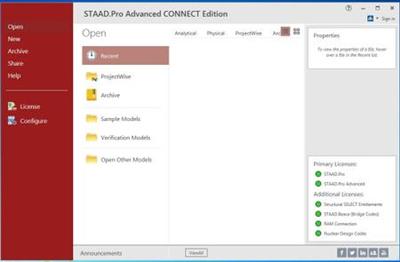Bentley Systems Incorporated is pleased to announce the availability of STAAD.Pro CONNECT Edition V22 Update 2. This version adds great new functionality to improve efficiency for engineers around the world and has resolved numerous issues that have been reported.
STAAD.Pro CONNECT Edition V22 Update 2 | 2.2 Gb
What is New & Changed in STAAD.Pro CONNECT Edition V22 Update 2 (22.02)
The following identifies the new features and enhancements that have been added in the CONNECT Edition V22 Update 2 of STAAD.Pro. These features have been selected to allow STAAD.Pro to deliver a greater range of capabilities required by engineers around the world.
General Developments
Physical Modelling Loading
The growing adoption of the Physical Modeller Workflow as the primary method for defining the STAAD.Pro analysis model has been enhanced with more loading options including adding wind and snow definitions, variable surface and hydrostatic loads, temperature and strain loads, and inclined nodal loads.
Backup Manager
The existing archive and autosave features have been replaced by the Backup Manager and Auto-Recovery.
Features Affecting the Analysis and Design Engine
IS 1893
Seismic joint checks can now be performed per Clause 7.2 of IS:13920-2016. This is used to check the relative strength of beams and columns in concrete lateral load resisting systems.
IBC 2018
A pair of enhancements to IBC 2018 have been added. When designing models that are subject to response spectra loading as defined in the IBC specification can now use the loading as defined in the 2018 code (referring to the ASCE 7-2016 publication). Seismic irregularities as defined by ASCE 7-2016 can now also be checked.
Features Affecting Postprocessing
Multiple Steel Design Results
For designs per AISC 360-16 or AISC 360-10, you can now selected different steel design parameter sets in the Postprocessing workflow when multiple sets are included in the input file.
RAM Connection Update
RAM Connection CONNECT Edition V13.1 is now supported in the Connection Design workflow. This edition includes connection design per the NZS 3404 1997 (New Zealand) code.
(A) Analysis/Design Engine (44)
(B) Generic GUI Updates (26)
(C) Analytical Modelling Workflow (13)
(D) Physical Modelling Workflow (14)
(E) Other Modelling Workflows (01)
(F) Analysis Post Processing Workflow (05)
(G) Other Post Processing Design Workflows (05)
(H) Interoperability (02)
(I) The Editor, Viewer and Other Modules (06)
(J) OpenSTAAD (04)
(K) Documentation and Printing (04)
(L) Licensing / Security / Installation (02)
(A) Analysis/Design Engine (44)
A) 01 The routines used for the design of columns in ACI 318-05/08/11 have been updated to account for the strength reduction factor specified in section 9.3.2 of these codes. Two changes implemented include a) to be recalculated for each estimated position of the neutral axis and b) addition of a new parameter to set the value of alpha used in the calculation
A) 02 The IBC 2018 / ASCE 7 16, response spectrum loading routine has been added with data from USGS provided to determine the S1 and SS parameters from either a ZIP code or the site longitude and latitude.
A) 03 The AITC design routine has been updated to ensure that the output reports the actual shear stress for the critical location.
A) 04 The Eurocode steel design routine for EN1993-1-1 for tubular sections has been updated to ensure that the determination of the depth between fillets is consistent when determining the section classification under axial or bending forces.
A) 05 The Australian concrete design module AS 3600 has been updated to include the details of beams in the output of the material take off. Previously this would only include the details of the columns. Additionally note that the volume of concrete from the elements is now included (not details of any reinforcement)
A) 06 The Russian dynamic wind load to SP 20.13300.2016 has been updated to support the definition of the ground level (additional parameter 'GL' the value being the Y ordinate in the model) which was previously taken as the lowest Y ordinate of the model.
A) 07 The Indian concrete design code IS 13920 Ductile Design and Detailing of Reinforced Concrete Structures Subjected to Seismic Forces - Code of Practice has been updated to include the provisions of clause 7.2. The details of the nodes with beam and columns connected can be seen by using a TRACK 4 for the output.
A) 08 The deflection check performed by the Japanese steel design codes AIJ 2002 and 20056 have been updated such that the results are now reporting the governing ratio for any part on the members that would be part of a physical member defined between DJ1 and DJ2. Hence note that the maximum deflection may not occur on the specific member, but is that which governs the design.
A) 09 The routine that calculates the section properties of UPT wide flange sections (either WIDE FLANGE or ISECTION) address a defect in the calculation which could result in an over estimate the major axis plastic modulus. Whilst this would not affect any analysis, it would impact a design of these members with any code that utilises the plastic properties.
A) 10 The routine that reduces the live load has been updated to ensure that the floor loads are converted to kip/in2 to determine the appropriate reduction factor.
A) 11 The AISC 360-16 steel design of members in tension has been updated to improve the calculation of slenderness, ensuring that the considered length uses the maximum of the assigned length and factors in both directions.
A) 12 The output for a deflection check of a AISC 360-16 steel design has been updated to ensure that the values of allowable deflection are correctly reported. The check itself was being reported correctly.
A) 13 The slenderness checks in the Japanese AIJ steel design modules 2002 and 2005 have been updated. The parameter MAIN is now designed only to work with the range of 0 to 250. If specified with a value of 1.0, the slenderness check will be bypassed. If specified with a value of 0 (or if not specified), the program will limit the slenderness of the member, if subject to compression loading, to 200. Any other value assigned to the MAIN parameter will be used as the limit. For members subject to tension loading a similar behaviour will be followed with the TMAIN parameter using a value of 400 if not specified of specified with a value of 0.
A) 14 The design of columns under tension to the Indian concrete code IS 456 with the minimum moments as per clause 25.4 using the parameter METHOD 1 has been implemented. Although the design was considered, the details were previously not output.
A) 15 The routine that reports the intermediate section forces in the output file has been updated to an issue introduced in Spro CE 21.00.02 that meant that the values were zero in the output file (although correctly displayed and reported in the post processing workflow).
A) 16 The US concrete column designs to ACI 318 2002, 2005, 2008 and 2011 design codes have been enhanced with a new ALPHA parameter which allows modification of the exponent for the Bresler contour method for biaxial interaction. Previously this was hard codes in the program as 1.24, but now can be set to account for differing cross sections. Default values are taken to be 1.5 for rectangular and 2.0 for square sections.
A) 17 The Indian concrete design to IS 13920 2016 has been updated to ensure that the details of the bars are correctly recorded which previously would result in column designs reporting as failed due to the column being less than 20 times the diameter of the longest longitudinal bar.
A) 18 The Floor Diaphragm irregularity checks have been extended to include the check option to IBC 2018 / ASCE 7 16. A model that has floor diaphragms defined in the Specifications >Node Specifications>Floor Diaphragm, can include irregularity check from the Analysis and Design layout> Miscellaneous Commands>Floor Diaphragm Options.
A) 19 Sections defined using a UPT GENERAL allows the definition of the shear areas AYY and AZZ, however, rather than using the provided values, the analysis was re-calculating these based on the provided dimensions. This has been changed such that the values provide will be used.
A) 20 The analysis results of a dynamic Russian wind load case of a model with multiple analysis/change commands has been corrected. The static loading vector now accounts for the inclusion of any additional analysis/change commands.
A) 21 The calculation of the term p-lambda-b, the plastic critical slenderness ratio in the Japanese 2005 AIJ steel design modules for determining the allowable bending stress fb (defined in eqn 5-14) has been updated to use the unsigned values of the end moments.
A) 22 The inclusion in the output file of any notes that 'Torsion and deflections have not been included in the design.' has been added to the count of notes reported at the end of the analysis messages.
A) 23 The AISC 360-16 steel design has been updated for HSS sections to use a fillet radius of 0.5t when determining the shear area and shear strength.
A) 24 The AISC 360-10 steel design deflection check routine has been updated to support the GENRATE option when using an SRSS load combination command.
A) 25 The design of angle sections to AISC 360-16 has been updated the section modulus calculation about the weaker v-v axis. Previously, the distance to the stress points did not correctly account for the relative position to the centroid which resulted in an incorrect interaction check.
A) 26 The design of angle sections using the geometric axes to the AISC LRFD design code has been updated. The location of the centroid for a second or subsequent angle is now recalculated.
A) 27 The routine that selects a section profile based on a deflection check using the parameter TRACK 4, has been updated for the BS5950, AISC 360, CSA S16, IS 800- LSD & WSD, NZS 3404 codes. Previously the method that estimated a new maximum deflection that would result with the new profile used the section properties of the previous step in the selection rather than the properties of the original profile.
A) 28 The analysis of models with temperature loading has been improved by reducing the use of a temporary file that could throttle the performance. This can significantly reduce the analysis time if the analysis is being performed on a model that is located on a remote network drive.
A) 29 The processing of the command SET ITERLIM, used to set the maximum number of iterations to be used for models that have tension only or compression only members and/or supports, has been updated to ensure it is used in the 64-bit analysis engine.
A) 30 The analysis of large models hosted on a remote network drive has been improved. If the intermediate member axial and/or torsion forces data cannot be held in the memory available, temporary files are created which are now better managed.
A) 31 The steel design routines to AISC 360-05 and 10 have been updated to ensure that if they are using a LOAD LIST which includes load cases created using the GENERATE option in an SRSS load combination, then these are included in the design checks.
A) 32 The direct analysis routine has been improved to ensure that if the model includes multiple seismic or response spectrum load cases, then each should have a PERFORM DIRECT ANALYSIS followed by CHANGE. If not present this is reported as an error.
A) 33 The IBC 2018 /ASCE 7-16 seismic load calculations have been extended to account for the exceptions 1 and 2 defined in clause 11.4.8. When the site class is E, for exception 1, with Ss > 0.75, Fa is that of site class C. For exception 2, with S1 >= 0.2 and time period T >= 1.5Ts, then Cs is taken as 1.5 x value obtained from eqn. 12.8.-3 or 12.8-2.
A) 34 The IBC 2018/ASCE 7-16 seismic code has been updated so that the spectral acceleration parameters SS and S1 are obtained from the publication from data provided by the USGS that match the ASCE 7-16 data rather than the ASCE 7-10 data that was provided previously.
A) 35 The IBC 2006/2012/2015 seismic loading modules have been updated to address an issue in determining the values of Fa and Fv when not specified. The values use a soil classification (site class) one lower than defined in the model.
A) 36 The Direct Analysis routine has been updated to address an issue which would always iterate on Tau-b, even if the option to include the iteration has been turned off.
A) 37 The reporting of concrete beams designed to ACI 318-14 which include the torsion checks has been updated to address a tolerance issue which was causing members that provide sufficient reinforcement and thus have a resulting ratio of 1.0, thus ok, but would report as a FAIL.
A) 38 The analysis routine that checks for local member instabilities as a result of excessive assigned releases of degrees of freedom has been updated with an increased accuracy for better detection and reporting of warnings in the output file.
A) 39 The analysis engine has been updated to ensure that it can support models with up to 400,000 nodes (although note that there may be other limitations that may restrict the overall size of model that can be solved).
A) 40 The routine that is used for the design of angle profiles for bending about their geometric axes and fully restrained against LTB to the US steel design code AISC 360-16 has corrected an issue in converting the moments from the principal axes.
A) 41 The routine used in the AISC 360-16 design of single angles has been updated to correct an error discovered in the calculation of beta-w used in determining Mcr in the lateral torsional buckling check which may affect designs if the member was short and subject to LTB and the shear center is in tension due to bending.
A) 42 The IS 1893-2016 response spectrum module has been updated with regard to the default value of DEC (factor for static eccentricity used to determine the design eccentricity according to IS 1893-2016 clause 7.8.2) used when torsion is considered. The default value of DEC is taken to be 1.5 unless the parameter ECC is provided and
A) 43 The routine used in the IS 1893 2016 response spectrum analysis for a 2D frame (i.e STAAD PLANE) has been updated to address an issue where the modification of forces by the factor given in clause 7.7.3 of Vb(bar)/Vb was not being accounted for. 3D frames were being modified correctly.
A) 44 The design of angles in bending in the AISC 360-05 and 10 design modules have been updated to address an issue where the sign of the moment about the v-v (i.e. minor) axis was not being handled correctly. If th4e moment was putting the tip of the angle legs into compression, then this could result in over estimating the bending capacity.
(B) Generic GUI Updates (26)
B) 01 The 3D rendering routine has been updated to address an issue encountered when model has identified errors with curved members reported when opened which have not been addressed. The program will now render the model but not the curved members.
B) 02 The routine that is used to display and edit values in some edit boxes such as defining the offset, has been updated to prevent a crash when the value entered was a fractional number in excess of 1.
B) 03 The control that lists the current load case in the Analytical Modelling>Loading ribbon and Post Processing>Results ribbon has been updated to support a mouse scroll to allow quick change of the currently displayed load case.
B) 04 The routine that provides a warning ahead of attempting to perform an analysis across a network which can result in a slow analysis with larger models, if set in the Configuration dialog, has been updated to ensure that the warning message is displayed when the check is set.
B) 05 The Application Search tool has been extended to include searching the text associated with each command icon as well as the title and descriptions to aid in finding relevant commands.
B) 06 STAAD.Pro file processing has been updated to support models located in a folder such that the path include a $ character which may occur when accessing a shared folder
B) 07 A new option has been added to the View Ribbon>Views>View Management>Export View which will create an image file of the current window in either BMP, JPG, TIF or TGA formats
B) 08 The current state of the ribbon and workflow panel is now saved when the application is closed and when it is reopened, the last state of these is returned.
B) 09 The process that is used to create a new file has been updated to allow new files to be created on a remote network drive.
B) 10 The GUI has been updated to improve the handling of models which have the FINISH command followed by a large amount of text such as when the FINISH command is inserted into a model to reduce the file size and commands to be processed. Previously this data following the FINSH command could take a significant time to process and lock up the GUI when displaying the analysis or design dialogs.
B) 11 The file parsing routine has been updated to ensure that the sign of the ECC parameter is accounted for in a response spectrum definition. Previously, a negative value would be converted to positive when the file is re-saved. Note that the analysis would use the sign that was present in the STD file.
B) 12 The Section Database management has been improved by providing the Default Database Configuration from the main application Start Screen without having to first load a model.
B) 13 Quick access to the commands in the ribbons has been added using Access Keys. This is initiated by clicking the ALT key followed by one of the keys that are displayed as labels on the ribbon tabs or commands.
B) 14 The database of Chinese steel profiles has been updated to GB/T 706 2016
B) 15 The news feed displayed in the Start Page has been updated to support HTML hyperlinks to help provide quick links to web pages.
B) 16 The routine that recorded the version of analysis solver used and listed in the model properties window of the backstage has been corrected to ensure that the correct analysis solver user is reported.
B) 17 A configuration option in the Options section, has been added to provide a local folder to act as a temporary location to perform an analysis on a model hosted on a remote network drive. Analysis of a model hosted in a remote location can result in an extended analysis time due to managing network communications.
B) 18 The Save As routine has been updated to ensure that when using a models that is hosted on a ProjectWise repository, the model on PW is also checked back in.
B) 19 The process that handles modeless dialog boxes has been updated to address an issue which would cause the application to crash in the post processing workflow on a Windows 7 operating system.
B) 20 The file parsing routine has been updated to support an OBLQUE option on a Russian Dynamic wind load which was previously causing the application to terminate.
B) 21 The GUI has been updated to address an issue that would terminate the program when changing views on a model that had an envelope defined, but did not include any load cases.
B) 22 The routine used to copy data to the clipboard from the Beams table has been updated from being 3 significant figures, to 3 decimal places.
B) 23 A new Backstage sheet to Backup/Restore earlier versions of the current model. To compliment this the automatic backup system has been updated to improve the ability to retain data in the event of a premature termination of the application.
B) 24 The Beam Tools context ribbon command 'Define Section Profile' has been updated to prevent the program from terminating when it is activate and clicked on.
B) 25 The application routine that processes the associated data files such as results files has been updated. This is to address an issue that could occur after modifying a model which has a set of results already loaded and no longer valid. This issue would result in the application terminating, but would successfully load the model when the application is restarted.
B) 26 The internal processing of windows messages that occur when windows are being updated or redrawn has been updated to handle events where multiple messages occur simultaneously to ensure that a suitable sequencing of handling the messages is adopted.
(C) Analytical Modelling Workflow (13)
C) 01 The routine that is used to delete a floor group has been updated to ensure that if any floor loads have been assigned to the floor group, they are also deleted from the model.
C) 02 The Aluminium Design dialog for defining the US Aluminium parameter ALLOY has been updated as the GUI was saving the index of the alloy offset by one.
C) 03 The routine that is used to merge members has been updated to ensure that if self weight has been applied to two members that have been merged, the load from only one remains whereas for all other applied loading, the loads from both would remain on the remaining member.
C) 04 The routine to calculate the wind loading according to ASCE 7 has been updated to correct the gust calculations for determining the gQ and gV factors in all the implemented versions of the code. Additionally if the calculated natural frequency of the structure is less than 1Hz and the height to minimum width
C) 05 The GUI has been updated to ensure that the Russian Dynamic wind load is not defined as an internal load as this is not a supported method.
C) 06 A new member attribute type has been added 'MEMBTYPE' which allows members to be classified with meta data that can be used with other parts of the program such as identifying the column for the connection design.
C) 07 The Analytical Modelling Design dialogs have been updated to ensure that when a new command is added, the selected point in the dialog remains constant allowing additional commands to be added at the same point.
C) 08 The GUI has been updated to provide a warning if UPT section profiles are defined that are more than 36 characters long and no longer terminate the application when displaying the Properties or Specifications dialogs.
C) 09 The process adding a new parametric model (mesh) has been modified to simplify the actions needed to define the mesh with a single dialog rather than the two dialogs used previously.
C) 10 The routine used to define a solid pressure load onto a model has been updated to ensure that when creating the load, a face number has been defined. A warning is reported if a face has not been assigned when attempting to create the command.
C) 11 The layout of the wall area specification in a seismic load definition has been simplified. Note that this is currently only used with the IS 1893-1 2016 definition with a type 4 structure, i.e. Building with RC walls.
C) 12 The GUI has been updated to ensure that if a model has been analysed and has results, the assignment of a member attribute would invalidate the current set of results and update the model which would need to be reanalyzed. Previously this would cause the application to terminate.
C) 13 The calculation of the gust factor in the ASCE-1995,2002,2010 wind loading module for 'chimney' tank and similar structures', 'Solid signs', 'Open Signs', 'Lattice framework' and 'Trussed tower' has been modified to consider their specific damping and frequency. Previously the frequency and damping was determined using that of 'Building Structures' for all types of structures.
(D) Physical Modelling Workflow (14)
D) 01 A new loading option has been added to allow variable pressure loading to be assigned to surface objects. The pressure at any point is determined by defining the pressure at three nodes on the surface.
D) 02 A new loading option has been added to allow hydrostatic loading to be assigned to surface objects. A quick method to define a variable pressure on surfaces based on a density and defining the zero pressure level.
D) 03 The processing of 'Area Loads' has been simplified such that it is now no longer necessary to generate the loading prior to creating the analytical model. This will now be done automatically.
D) 04 The Surface Definition is now used as the Title of the parametric model created in the STD file.
D) 05 The Physical Modelling workflow has been enhanced with the option to apply thermal loading on members and surfaces.
D) 06 Node loading in the Physical Modelling workflow has been enhanced to support the assignment in no global directions using a user defined axes system. Also the option to reference a common location, the origin of a UCS, allows radial loading to be defined.
D) 07 The validation routine for circular openings has been updated too ensure that it did not check against openings defined in other surfaces.
D) 08 The Indian seismic loading module has ben extended to provide the option of defining the wall areas when the structure type has been specified as a 'Building with RC Structural Walls' in order to determine the approximate fundamental natural period Ta according to clause 7.6.2 of IS 1893-1 2016.
D) 09 The Physical Model workflow now supports the definition and assignment of static and dynamic wind loads. The definitions have been added to the catalog and can be assigned to load cases defined with the appropriate category.
D) 10 The Physical Model workflow now supports the definition and assignment of snow loads. The definitions have been added to the catalog and can be assigned to load cases defined with a SNOW DEFINITION category. The definition of the roof to be loaded should be defined as a GROUP which includes the members that would be loaded.
D) 11 The Physical Model can be set to generate combination cases as primary load cases using a factored REPEAT method which allows models to use non-linear methods of analysis. The required method is set in the Options dialog.
D) 12 The surface object has been enhanced with a categorisation attribute that allows them to be classified as Walls or Slabs which will be used in future to assist in determining the appropriate design methodology to follow.
D) 13 A few dialogs have been modified to allow the displayed text to be localised for international versions of STAAD.Pro.
D) 14 The Physical Modeller has been enhanced with a new tool to editing characteristics of a selected surface such as redefining the boundary points and adding openings.
(E) Other Modelling Workflows (01)
E) 01 The import routine for obtaining the pipe model from an AutoPIPE PipeLink database has been improved to ensure that the test for the axis system is based on the configuration defined in the model rather than that of the application.
(F) Analysis Post Processing Workflow (05)
F) 01 The routine used to determine the stresses along a cutline in the 'Results Along Line' layout, has been re-written to produce more accurate evaluation of th4e stresses/forces away from the centroid of the plates.
F) 02 The Post Processing routine that displayed the output for a GNL analysis has been updated to prevent a crash if the current view did not contain all the members in the structure.
F) 03 The Design Results table in the Post-Processing workflow has been updated to support sets of results from multiple CODE CHECK or SELECT commands associated with the AISC 360-16 design code.
F) 04 The results of a Geometric Non Linear Analysis (GNL) has been re-introduced into the post processing workflow allowing the progression of a node displacement or the beam force at each iteration of the analysis to be graphically displayed.
F) 05 The routine that manages the Results Setup dialog > Modes content has been updated to address an issue when that would cause the application to terminate, by following a change in the modes with a change in the Range.
(G) Other Post Processing Design Workflows (05)
G) 01 The Connection Design workflow has been updated to allow the support of connections where the column is defined from a hollow section. In order to achieve this, the column needs to take advantage of the recently added capability of assigning a MEMBTYPE member attribute on the column. See also C) 06.
G) 02 The Gusset Base Plate module in the Connection Design workflow has been updated to account for when bracing members have been connected to the web of the column.
G) 03 The designs of connections in the Steel Connection workflow have been updated to ensure that the if a bolt type is set as 'slip-critical', that setting is used in the design.
G) 04 The Steel Connection workflow has been enhanced with the inclusion design templates to the New Zealand code NSZ 3404-1997 (basic and smart, not gusset) as found in RAM Connection V13.1.
G) 05 The connection design report has been updated to ensure that where the text is used as a subscript such as when displaying an equation that has a variable raised to a power, then the text following this is returned to the base line.
(H) Interoperability (02)
H) 01 The ISM routines used in the analytical model have been updated to address an issue that could be encountered when the STAAD model is hosted on a network drive which would result in the ISM interop reporting 'Unable to connect STAAD.Pro instance'. This issue has been addressed.
H) 02 The ISM interop provided in the Physical Modelling workflow has been updated to address an issue that occurs when updating a repository after modifying a surface which would report errors and the surfaces failed to export.
(I) The Editor, Viewer and Other Modules (06)
I) 01 The TATA Structura 2014 profile database has been added to Section Wizard for both Section Builder and FreeSketch modules.
I) 02 The Output Viewer has been updated to alow the header/footer to be be included/excluded from the print document.
I) 03 The Indian section database in Section Wizard has been updated to include the WPB and NPB sections.
I) 04 User settings defined for the Editor and Output Viewer are now saved when exiting STAAD.Pro and these will be used when the application is next run.
I) 05 The Editor application has been updated to include a quick find bar to help quickly locate text in the data file.
I) 06 The Structure Wizard module has been updated to locate the data of the saved templates (default.stp), into a location that allows it to be updated with user settings.
(J) OpenSTAAD (04)
J) 01 A new OpenSTAAD function has been created GetNewPrimaryLoadEx2. This takes three parameters for the title of the load case, the load category (as an index) and the load case number. See the OpenSTAAD Application API documentation for more details on this and the other available functions.
J) 02 Two new OpenSTAAD functions have been added to assist in working with models that include inactive members. Property.GetInactiveMemberCount indicates the number of members that have been marked as inactive for the analysis. The list of these inactive members can be obtained by using the function Property.GetInactiveMemberList(inactiveMemberList)
J) 03 The OpenSTAAD function Geometry.GetSelectedNodes() has been updated to ensure that the returned list of nodes excludes any nodes that were previously selected, but have been deleted.
J) 04 A new OpenSTAAD function has been added to obtain the complete job information data, GetFullJobInfo() along with the complimentary SetFullJobInfo(). See the OpenSTAAD documentation for details.
(K) Documentation and Printing (04)
K) 01 The Technical Reference documentation sections GS. Limits on Models and TR.2 Problem Initiation and Model Title have been updated with additional guidance on the determination of the memory demands.
K) 02 The details for the Indian design codes documented in the Design section of the help have been re-ordered into a more logical sequence.
K) 03 The documentation in topic TR.37.4 Buckling Analysis has been updated to clarify the format required to perform an eigen method of buckling analysis (only valid for STAAD.Pro Advanced)
K) 04 The documentation for Russian wind loading has been updated in topic TR.32.12.3 Generation of Wind Loads, to clarify the requirements of the various versions of the command.
(L) Licensing / Security / Installation (02)
L) 01 The installation has been updated to include completed versions of the tutorial files.
L) 02 The installation has been updated to include version 9.0.0.21 of Advanced Concrete Design module RCDC. Note that this is a free module with STAAD.Pro Advanced.
STAAD.Pro CONNECT Edition is the most popular structural engineering software product for 3D model generation, analysis and multi-material design. It has an intuitive, user-friendly GUI, visualization tools, powerful analysis and design facilities and seamless integration to several other modeling and design software products. The software is fully compatible with supported Windows operating systems.
For static or dynamic analysis of bridges, containment structures, embedded structures (tunnels and culverts), pipe racks, steel, concrete, aluminum or timber buildings, transmission towers, stadiums or any other simple or complex structure, STAAD.Pro has been the choice of design professionals around the world for their specific analysis needs.
In this video you will learn how to create a new project in STAAD.Pro. Topics include specifying STAAD.Pro's configuration , how to create a new file and how to create model geometry using STAAD.Pro's Structure Wizard.
Bentley Systems, Incorporated. is the global leader dedicated to providing architects, engineers, constructors, and owner-operators with comprehensive architecture and engineering software solutions for sustaining infrastructure. Founded in 1984, Bentley has nearly 3,000 colleagues in more than 45 countries, $500 million in annual revenues, and, since 2001, has invested more than $1 billion in research, development, and acquisitions.
Product: STAAD.Pro
Version: CONNECT Edition V22 Update 2 (build 22.02.00.26)
Supported Architectures: x64
Website Home Page :Language: englishโค้ด:http://www.bentley.com
System Requirements: PC *
Supported Operating Systems: *
Size: 2.2 Gb
The following hardware requirements are suggested minimums. Systems with increased capacity provide enhanced performance.
Processor Intel Pentium or AMD processor 3.0 GHz or greater.
Memory 1 GB minimum, 2 GB recommended (4GB for STAAD.Pro Advanced). More memory almost always improves performance, particularly when working with larger models. 4 GB (8 GB for STAAD.Pro Advancd) or more can help speed up solutions for very large complex models with large numbers of load cases.
Video Graphics card supported by OpenGL. See the graphics card manufacturer for latest information on graphics drivers. 256 MB of video RAM or higher is recommended. If insufficient video RAM or no graphics card supported by OpenGL can be found, the application will attempt to use software emulation. For optimal performance, graphics display color depth should be set to 24-bit or higher. When using a color depth setting of 16-bit, some inconsistencies will be noted.
Screen Resolution A minimum screen resolution of 1280x1024 is required, but higher is recommended.
Hard Disk Requirements will vary depending on the modules you are installing. A typical minimum is 500MB free space.
Supported Operating Systems
- Windows 10 (64-bit) - Home, Pro, Enterprise, and Education
- Windows 8.1 (64-bit) - Standard, Pro, and Enterprise
- Windows 7 SP1 (64-bit) - Home Basic, Home Premium, Professional, Enterprise, and Ultimate
Note: Windows 7 operating system is supported only if you have its service pack (SP1) installed.
Note: You must have the following Microsoft updates installed on your machine:
- KB4340917 - For Windows 10 Version 1803 Builds prior to 10.0.17134.191. The changes in KB4340917 are built into the August 2018 monthly update of Windows 10.
- KB2999226 - For Windows 7 SP1, Windows 8.1, Windows Server 2008 R2 SP1, and Windows Server 2012
- KB2999226 - For Windows 8.1 (64bit)
- KB2919355 - For Windows 8.1 and Windows Server 2012
Bentley does not support its software running on Microsoft operating systems versions that Microsoft has "retired".
Additional RAM, disk space, and video memory will enhance the performance of STAAD.Pro.
The minimum amount of physical + virtual memory required by the program is over 600MB. You may need to ensure that adequate amounts of virtual memory are available and that parameters such as paging file sizes should be large enough or span over multiple drives if the free space on any one drive runs low.
Another issue to keep in mind is the location of the TEMP parameter as in the SET TEMP environment variable in Windows. While performing calculations, depending on the structure size, the program may create very large scratch files which are placed in the folder location associated with the TEMP parameter. You may want to point the SET TEMP variable to a folder on a drive that has disk space sufficiently large to accommodate the requirements for large size structures.
You should have a basic familiarity with Microsoft Windows systems in order to use the software.
Download link:โค้ด:rapidgator_net: https://rapidgator.net/file/dd2d98ed5b85b786288cb5a6ba52e553/l6nch.STAAD.Pro.CONNECT.Edition.V22.Update.2.part1.rar.html https://rapidgator.net/file/e09b1ceee8fa845944fdaf2dab3424ba/l6nch.STAAD.Pro.CONNECT.Edition.V22.Update.2.part2.rar.html https://rapidgator.net/file/4995d31b9d6002477f751b2191593691/l6nch.STAAD.Pro.CONNECT.Edition.V22.Update.2.part3.rar.html https://rapidgator.net/file/5b6bfc6b75190cfa1bf4f8639baa02a7/l6nch.STAAD.Pro.CONNECT.Edition.V22.Update.2.part4.rar.html https://rapidgator.net/file/b89ce9597bcea71da6e22fbf7fc72fd1/l6nch.STAAD.Pro.CONNECT.Edition.V22.Update.2.part5.rar.html https://rapidgator.net/file/9be5825cb17dd167f32e0c51bbb7e812/l6nch.STAAD.Pro.CONNECT.Edition.V22.Update.2.part6.rar.html https://rapidgator.net/file/cc388000e557b87c7db4159a13a7e104/l6nch.STAAD.Pro.CONNECT.Edition.V22.Update.2.part7.rar.html nitroflare_com: https://nitroflare.com/view/B8EA2170EEFFC8D/l6nch.STAAD.Pro.CONNECT.Edition.V22.Update.2.part1.rar https://nitroflare.com/view/7807CC4D80DB2CB/l6nch.STAAD.Pro.CONNECT.Edition.V22.Update.2.part2.rar https://nitroflare.com/view/F195BD8222F726B/l6nch.STAAD.Pro.CONNECT.Edition.V22.Update.2.part3.rar https://nitroflare.com/view/7EA1B94DF9E1BFA/l6nch.STAAD.Pro.CONNECT.Edition.V22.Update.2.part4.rar https://nitroflare.com/view/B41E40D85015531/l6nch.STAAD.Pro.CONNECT.Edition.V22.Update.2.part5.rar https://nitroflare.com/view/AF2C0A0CB6EB0CD/l6nch.STAAD.Pro.CONNECT.Edition.V22.Update.2.part6.rar https://nitroflare.com/view/D11B31EEA4A1AFF/l6nch.STAAD.Pro.CONNECT.Edition.V22.Update.2.part7.rar uploadgig_com: http://uploadgig.com/file/download/Dc708340116fed25/l6nch.STAAD.Pro.CONNECT.Edition.V22.Update.2.part1.rar http://uploadgig.com/file/download/018d6e1b82bC66B5/l6nch.STAAD.Pro.CONNECT.Edition.V22.Update.2.part2.rar http://uploadgig.com/file/download/1889ddf7e7670f09/l6nch.STAAD.Pro.CONNECT.Edition.V22.Update.2.part3.rar http://uploadgig.com/file/download/f6c60E1b4F28f654/l6nch.STAAD.Pro.CONNECT.Edition.V22.Update.2.part4.rar http://uploadgig.com/file/download/752C6F70190F0067/l6nch.STAAD.Pro.CONNECT.Edition.V22.Update.2.part5.rar http://uploadgig.com/file/download/be201771f569A694/l6nch.STAAD.Pro.CONNECT.Edition.V22.Update.2.part6.rar http://uploadgig.com/file/download/3f0adbc1F6848736/l6nch.STAAD.Pro.CONNECT.Edition.V22.Update.2.part7.rarLinks are Interchangeable - No Password - Single Extraction
 |
 |
 |
 |
 |
 |
 |
 |
 |
 |
 |
 |
 |
 |
 |
เว็บไซต์เราจะอยู่ไม่ได้หากขาดเขาเหล่านี้ รวมช่วยกันสนับสนุนสปอนเซอร์ของพวกเรา
กำลังแสดงผล 1 ถึง 1 จากทั้งหมด 1
-
27th October 2019 15:29 #1ชอบโพสต์เป็นชีวิตจิตใจ

- วันที่สมัคร
- Jun 2019
- กระทู้
- 61,141
- กล่าวขอบคุณ
- 0
- ได้รับคำขอบคุณ: 21
STAAD.Pro CONNECT Edition V22 Update 2
















 ตอบพร้อมอ้างถึงข้อความเดิม
ตอบพร้อมอ้างถึงข้อความเดิม
